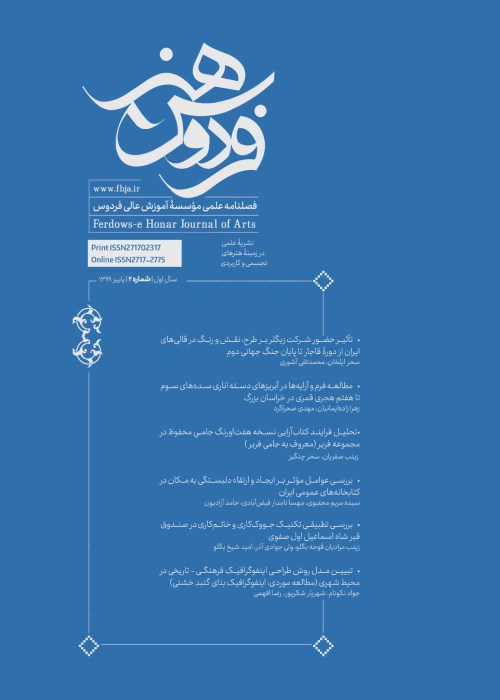A Typological Study on Iranian Metal Lamp Stands from Medieval Islamic period
Iranian metal lamp stands, especially from fourth century onwards, are considered as one of remarkable pre-modern lighting devices from medieval Islamic period. They are, as it is clear form their names, kinds of tall stands on which they would put an oil lamp to make a space as light as possible. During medieval Islamic period, forms and designs of Iranian metal lamp stands have gone through major changes and developments. Among their outstanding forms there are lamp stands with concave bases and hooked feet, which have been appeared and flourished during fifth and sixth century A. H. While Lamp stands probably appeared for the first time in the early Islamic period in Iran, their exact origin is not clear. They may be derived from some neglected forms of ancient Iran or from other neighbor cultures of Islamic Iran like Byzantine. In all it is undeniable that these products featured by Iranian design culture in the Islamic period. Therefore, the main problem to which this study has been dedicated is to depict the process of developments of Iranian metal lamp stands from Medieval Islamic period and thus to introduce their main typological characteristics. This essay studies on the developmental process and typological characteristics of metal Lamp stands from Islamic period in Iran. In this research, we tend to either figure out the step by step evolution process of these Lamp stands or show how to study the other historical devices. The main question of this research is what the typological characteristics of metal lamp stands of Iranian design are. Here, in order to go through this question, I have applied descriptive analytical method of research. The method of data gathering for this inquiry, therefore, is obviously that of desk study. Thus, I have followed and considered the development process of mostly bronze and brass Lamp stands from medieval Islamic Iran. And, studying the most important changes in design styles, the route that they have passed from the beginning of the Islamic period until eight century A. H., is recognized and depicted. Furthermore, I have decided to choose a new approach to the history of object’s design suggested by Vyas, an Indian scholar. According to Vyas, in order to be a major landmark a moment in the history of an object should indicate five kinds of changes: changes in design and structure of devices; changes in appearance of them; changes in methods of manufacturing; changes in the ways they have been used; and finally changes in objects’ relationship with their users. Therefore, according to these principles the most important change steps during development process of Iranian lamp stands from Islamic period can be characterized in three main typological groups. While first group contains lamp stands with concave bases and hooked feet, the second one consists of lamp stands with domed bases and hooked feet. And, Finally in the third group there are lamp stands only with domed bases and no hooked feet. It seems that, due to expansion in cultural and political relation of Islamic society and Byzantine world, the prototype of lamp stands has emerged under the Mediterranean influences. There has been survived candlesticks from Byzantium that share a great deal of elements with our lamp stands from group one. Especially, concave bases has to mentioned here. Nevertheless, at the same time, one can speak of the influences coming from pre Islamic Iranian design features when it comes to hooked feet. These characteristic feet are always present in the design of lamp stands and only disappear in the objects of the third group. The other characteristic feature in the design of these devices are their tall shafts. Although rarely are they intact, but it is clear that some of them are modular with globular units, while others are made of pierced metal sheets. The influences of architectural columns are evident in design of some of these shafts. Bases are also important. Whereas, bases of lam stands in the first group are characteristically concaved, bases in the second group have been through a remarkable change and introduced simple domed shapes on hooked feet. Still in the third group, these doomed shaped bases have become stepped in profile. At the end, it was revealed that the design development process of Iranian lamp stands of medieval Islamic period has been ceased as soon as their application has been reduced in Iranian society. It has been observed that the cessation of these lighting devices has coincided with the flourishing industry of known Islamic candlesticks manufacture.
- حق عضویت دریافتی صرف حمایت از نشریات عضو و نگهداری، تکمیل و توسعه مگیران میشود.
- پرداخت حق اشتراک و دانلود مقالات اجازه بازنشر آن در سایر رسانههای چاپی و دیجیتال را به کاربر نمیدهد.


